Hello dear readers! Have you ever picked up a boho bag and wondered what makes it feel so vibrant, so alive with personality? Well, one of the secrets lies in the colorful beadwork, and when that beadwork comes from the hills of Himachal, it carries more than just beauty—it carries a story.
In Himachal Pradesh, beadwork has been a traditional craft passed down through generations. Each bead is stitched with patience, care, and a touch of local culture.
So, the next time you sling a beaded boho bag on your shoulder, remember—you’re not just carrying style, you’re carrying history too!
History and Cultural Significance
- Roots in Himalayan Craft Traditions
- Beadwork from Himachal Pradesh has origins in the tribal and rural households of the Himalayas.
- It started as a form of personal adornment where beads were used in jewelry, hair ornaments, and clothing borders.
- Beadwork from Himachal Pradesh has origins in the tribal and rural households of the Himalayas.
- Beads as Trade Items
- In earlier times, beads were brought into Himachal through trade routes connecting Tibet, Ladakh, and the plains of North India.
- Locals adopted them into their craftwork, blending outside influences with their own mountain-inspired designs.
- In earlier times, beads were brought into Himachal through trade routes connecting Tibet, Ladakh, and the plains of North India.
- Women as Keepers of Tradition
- Traditionally, beadwork was done by women at home, passed down from mothers to daughters.
- It was both a pastime and a way to decorate everyday objects—purses, belts, and fabric panels.
- Traditionally, beadwork was done by women at home, passed down from mothers to daughters.
- Religious and Festive Uses
- Bead-decorated cloth pieces were often used during festivals, weddings, and local rituals.
- Bright colors and intricate patterns were believed to bring luck and positivity.
- Bead-decorated cloth pieces were often used during festivals, weddings, and local rituals.
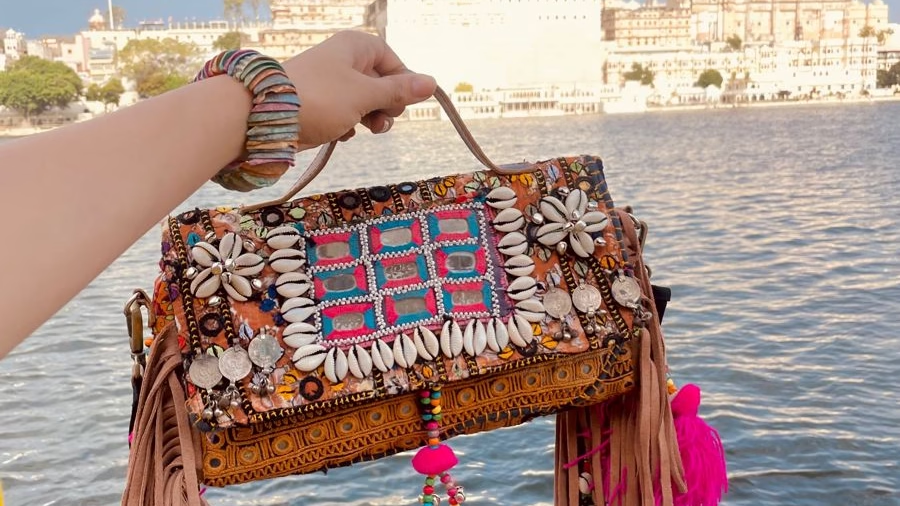
🎭 Cultural Significance of Himachali Beadwork
- A Mirror of Identity
- Beadwork reflects the cultural identity of Himachali tribes and communities.
- Each design carries a symbolic meaning—whether inspired by flora, fauna, or cosmic patterns.
- Beadwork reflects the cultural identity of Himachali tribes and communities.
- Connection to Nature
- Living amidst the Himalayas, artisans often wove mountain flowers, rivers, and stars into bead designs.
- This created a bond between craft and natural surroundings, making the art form deeply local yet universal.
- Living amidst the Himalayas, artisans often wove mountain flowers, rivers, and stars into bead designs.
- Color Symbolism
- Colors of beads held cultural messages:
- Red for energy and celebration.
- Blue for protection and calmness.
- Green for fertility and growth.
- Red for energy and celebration.
- These color choices turned simple bags and accessories into objects of meaning, not just style.
- Colors of beads held cultural messages:
- Community and Storytelling
- Beadwork often carried stories of community life, with motifs symbolizing unity, fertility, and protection.
- It was a social art, where women gathered to work together, weaving conversations into every design.
- Beadwork often carried stories of community life, with motifs symbolizing unity, fertility, and protection.
- Beadwork as Status Symbol
- In earlier times, heavily beaded accessories or garments reflected family pride and status.
- A richly decorated beaded item was considered a treasured possession in households.
- In earlier times, heavily beaded accessories or garments reflected family pride and status.
- Preservation of Heritage
- With modernization, beadwork risks fading, but its revival through boho bags and contemporary fashion gives it new life.
- Carrying such a bag today means carrying a slice of Himachal’s living tradition.
- With modernization, beadwork risks fading, but its revival through boho bags and contemporary fashion gives it new life.
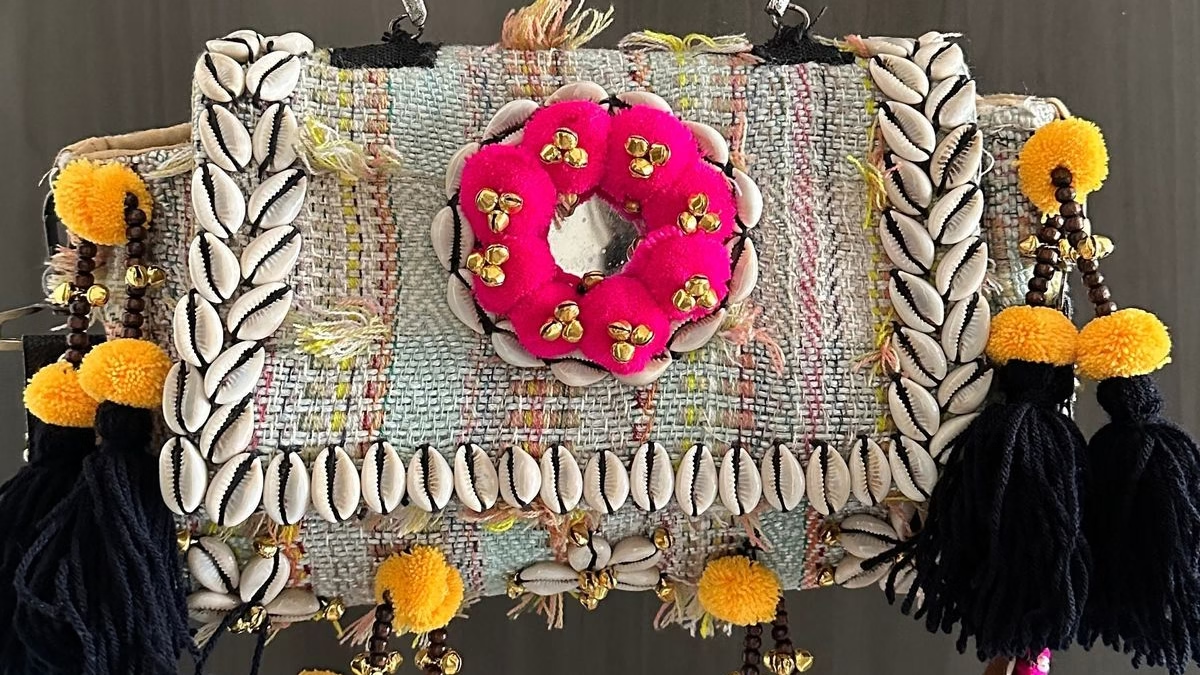
Material used and Steps of making
The materials in Himachali beadwork are simple yet carefully chosen. Each element adds its own charm, strength, or beauty to the finished Boho bag. Let’s walk through them one by one:
1. Beads: The Heart of the Craft
- Glass Beads: Traditionally used for their shine and color variety. They catch light beautifully, making patterns look lively.
- Wooden Beads: Offer an earthy, rustic touch. Often chosen when bags are meant to have a natural or eco-friendly vibe.
- Metallic Beads: Add sparkle and durability. Brass and copper beads are sometimes used to reflect Himachal’s folk jewelry styles.
- Plastic Beads: Affordable and lightweight, widely used in modern Boho bags for practical reasons.
2. Threads and Cords
- Cotton Thread: Strong, easy to knot, and flexible for intricate bead patterns.
- Silk Thread: Used for luxurious detailing, it adds smoothness and sheen.
- Nylon or Polyester Cords: Durable and resistant to fraying, perfect for modern bags that need to last longer.
3. Base Fabric for Boho Bags
- Woolen Fabric: Himachal is famous for wool; woolen bases provide warmth and cultural authenticity.
- Cotton Canvas: Commonly used for sturdiness and ease of handling.
- Jute and Hemp: Eco-friendly options that match the bohemian aesthetic while providing strength.
4. Needles and Frames
- Beading Needles: Thin, long needles designed to pass through tiny bead holes easily.
- Wooden Frames/Hoops: Used to hold fabric tightly in place while artisans weave beads into patterns.
5. Supporting Materials
- Leather or Faux Leather Straps: For bag handles, adding durability.
- Lining Fabrics: Cotton or polyester linings to strengthen the inside of the bag.
- Zippers and Clasps: Functional add-ons to complete the accessory.
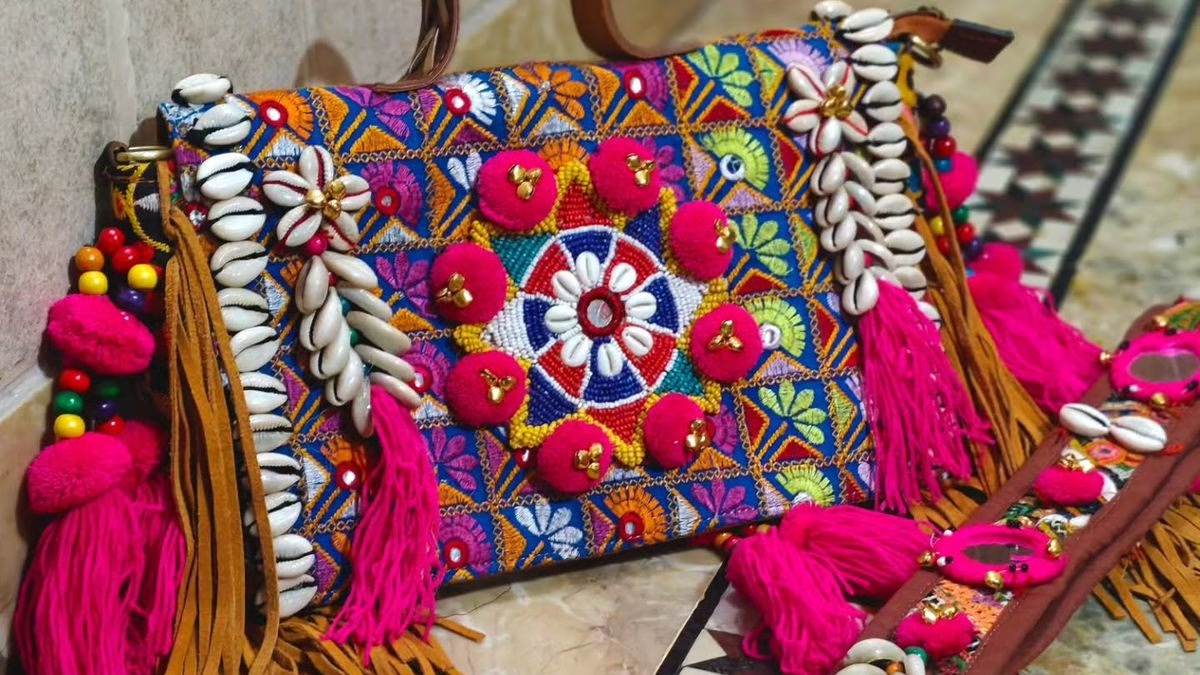
🧵 Steps of Making Himachali Beadwork in Boho Bags
Making beadwork, isn’t just about stitching beads, especially if you are aspecting Beadwork from Himanchal—it’s about patience, rhythm, and storytelling through patterns. Below are the step-by-step stages artisans usually follow:
Step 1: Preparing the Base
- The artisan selects the fabric base (wool, cotton, or jute).
- The fabric is stretched on a wooden hoop or frame to ensure it stays firm.
- A sketch or chalk outline of the pattern is made directly on the fabric, serving as a guide for bead placement.
Step 2: Sorting and Arranging Beads
- Beads are carefully sorted by color, size, and material.
- For intricate motifs, small beads are kept aside, while larger beads are reserved for borders or highlights.
- The sorting process ensures speed and precision once the actual beadwork begins.
Step 3: Threading the Needle
- The artisan selects the right type of thread based on bead size and fabric thickness.
- The thread is doubled or knotted at one end to secure it.
- In some cases, beeswax is applied to strengthen the thread and prevent tangling.
Step 4: Starting the Bead Embroidery
- Beads are picked up one by one with the needle and stitched along the outlined design.
- The artisan may work in straight lines, zig-zags, or curves depending on the motif.
- Each bead is anchored firmly with a backstitch or double stitch to ensure it doesn’t loosen with use.
Step 5: Creating Motifs and Borders
- Common motifs include geometric shapes, floral vines, and tribal-inspired symbols.
- Borders are often highlighted with larger or metallic beads to give a strong frame to the design.
- Contrasting colors are carefully placed to make patterns stand out on the fabric.
Step 6: Filling the Design
- Once outlines are complete, the inner parts of motifs are filled with smaller beads in multiple shades.
- This step requires patience, as consistency in bead alignment ensures a neat look.
- The filling also brings out depth and three-dimensional appeal.
Step 7: Securing the Beadwork
- After completing the bead design, the reverse side of the fabric is checked for loose threads.
- Extra knots are tied, and excess thread is trimmed to avoid fraying.
- Some artisans add a thin lining at this stage to protect bead threads from wear.
Step 8: Crafting the Boho Bag
- The bead-embroidered fabric is cut and stitched into the desired bag shape—be it a tote, sling, clutch, or backpack.
- Leather or jute straps are added for carrying convenience.
- Linings, zippers, or wooden buttons are attached to make the bag both beautiful and functional.
Step 9: Final Touches and Quality Check
- The bag is examined carefully for missing beads or loose ends.
- Beads are polished with a soft cloth to bring out their shine.
- Only after these checks is the bag ready to be sold or showcased.
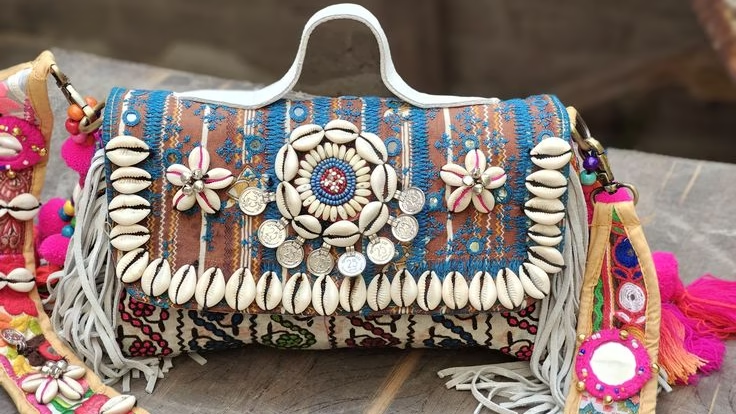
Symbols and Motifs in Beadwork from Himachal in Boho Bags
Beadwork from Himachal Pradesh is not just about decoration—it is a conversation in color, pattern, and symbolism. When these age-old motifs find their way into boho bags, they carry more than beauty: they carry fragments of culture, stories, and identity. Let’s explore the common symbols and motifs that shine through this craft.
🌸 1. Floral Motifs: Blossoms of the Hills
- Rhododendron Blossoms
- Inspired by the bright rhododendrons found in Himachal’s forests.
- Symbol of vitality, joy, and natural abundance.
- On boho bags, these motifs bring a cheerful, vibrant feel, making them stand out as youthful and nature-inspired.
- Inspired by the bright rhododendrons found in Himachal’s forests.
- Lotus Patterns
- Lotus is often used to represent purity and resilience.
- In beadwork, small circular arrangements form the petals.
- Ideal for central panels of bags, symbolizing inner strength.
- Lotus is often used to represent purity and resilience.
- Daisy and Small Floral Sprigs
- Daisies and simple wildflowers mirror the mountain meadows.
- Used as fillers between large motifs.
- Convey innocence and harmony with nature, giving bags a soft, welcoming vibe.
- Daisies and simple wildflowers mirror the mountain meadows.
🍃 2. Leaf and Vine Motifs: Threads of Continuity
- Creeper Patterns
- Long trailing vines symbolize growth, continuity, and life’s journey.
- They are often woven into borders of boho bags, acting like natural frames.
- Long trailing vines symbolize growth, continuity, and life’s journey.
- Pine Leaves
- Pine trees dominate Himachal’s landscape, and their needle-like leaves often inspire bead arrangements.
- Symbolize endurance and adaptability, especially in tough terrains.
- Pine trees dominate Himachal’s landscape, and their needle-like leaves often inspire bead arrangements.
- Circular Leaf Patterns
- Arranged in repetitive cycles to show rhythm and order.
- On bags, these motifs create flow and symmetry.
- Arranged in repetitive cycles to show rhythm and order.
🦚 3. Animal and Bird Motifs: Living Companions of Culture
- Peacock Designs
- The peacock stands for beauty, pride, and grace.
- In beadwork, stylized feathers are created using contrasting colors like blue, green, and gold beads.
- Adds grandeur and festivity to boho bags.
- The peacock stands for beauty, pride, and grace.
- Parrot Patterns
- Parrots are common motifs, associated with playfulness and love.
- Seen as lucky symbols, especially in Himachali folk traditions.
- On boho bags, they bring a lively, joyful energy.
- Parrots are common motifs, associated with playfulness and love.
- Sheep and Goat Motifs
- Himachal’s agrarian lifestyle often reflects in beadwork designs.
- Represent livelihood, abundance, and a connection to the land.
- These motifs bring a rustic and earthy character to modern accessories.
- Himachal’s agrarian lifestyle often reflects in beadwork designs.
🔺 4. Geometric Motifs: Symbols of Balance and Protection
- Diamond Shapes
- Called chowka, diamonds are widely used across Indian crafts.
- Represent balance, protection, and cosmic energy.
- In beadwork, rows of diamonds give a structured, shield-like effect to bags.
- Called chowka, diamonds are widely used across Indian crafts.
- Triangles
- Triangular shapes often symbolize mountains.
- In Himachali beadwork, they stand for stability and grounding.
- On boho bags, they instantly connect design to the land of hills.
- Triangular shapes often symbolize mountains.
- Chevron and Zig-Zag Lines
- Suggest rivers, movement, and flow.
- Add a sense of dynamism to bag panels, reminding wearers of adventure and journeys.
- Suggest rivers, movement, and flow.
☀️ 5. Spiritual and Cosmic Motifs: Faith in Beads
- Sunburst Designs
- Sun motifs symbolize energy, renewal, and divine power.
- Beaded suns often appear at the center of patterns, becoming focal points on bags.
- Sun motifs symbolize energy, renewal, and divine power.
- Star Patterns
- Represent guidance and hope, especially important for communities in mountain terrains.
- Stars woven in beads shine like little charms on the surface of boho bags.
- Represent guidance and hope, especially important for communities in mountain terrains.
- Mandala-Inspired Motifs
- Circular bead arrangements resembling mandalas show unity and wholeness.
- These motifs are deeply spiritual, often linked to meditation and harmony.
- Circular bead arrangements resembling mandalas show unity and wholeness.
🎨 6. Color as a Symbolic Language
- Red and Maroon Beads: Associated with energy, passion, and festivals.
- Green Beads: Symbolize fertility, freshness, and the hillsides.
- Blue Beads: Reflect the sky and rivers, signifying calmness and depth.
- Yellow and Golden Beads: Represent prosperity, sunlight, and celebration.
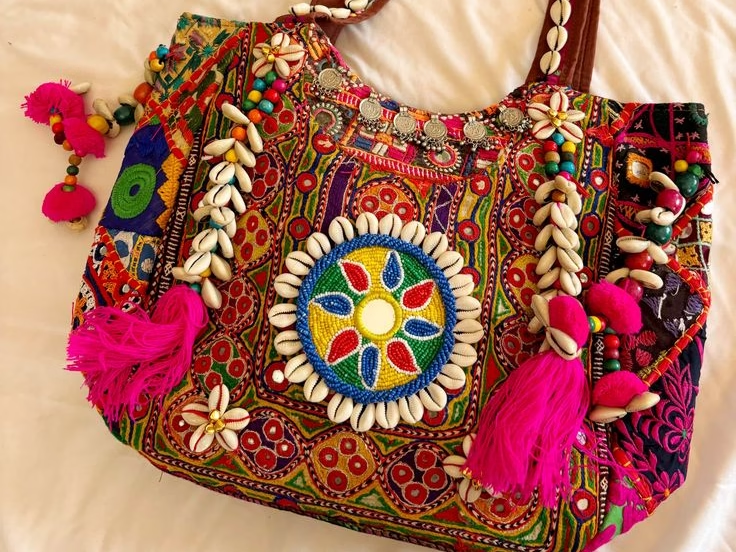
Statistics: Beadwork from Himachal in Boho Bags
When we talk about Beadwork from Himanchal finding its way into boho-style bags, it’s not just art—it’s also numbers, livelihoods, and a growing market story. Let’s look at the statistics in detail.
🧵 Craft and Artisan Base
- Artisan Population: Around 18,000–20,000 artisans in Himachal Pradesh are involved in embroidery, beadwork, and related crafts.
- Women’s Contribution: Nearly 70% of beadwork artisans are women, especially from rural districts like Kullu, Chamba, and Kangra.
- Skill Clusters: Small village clusters often have 5–10 artisan families dedicated to bead embroidery, passing skills across generations.
💼 Livelihood and Earnings
- Income Range: Traditional beadwork artisans earn around ₹6,000–₹10,000 per month if selling locally. With boho bag exports, some earn ₹15,000–₹20,000 per month.
- Supplementary Income: Beadwork is often a secondary income source for farming families, providing financial security during non-harvest months.
- Women Empowerment: Boho bag workshops and cooperatives have led to a 25–30% rise in women’s independent income in certain districts.
👜 Market Reach and Demand
- Domestic Sales: In India, boho bags with Beadwork from Himanchal sell mainly in Delhi, Mumbai, Goa, and Rajasthan tourist hubs.
- Export Market: Nearly 60% of Himachali beadwork boho bags are exported, with high demand in Europe and North America.
- Price Range: Depending on design and detailing, a boho bag costs ₹1,500–₹8,000 in boutique stores, much higher than local prices.
📈 Growth and Trends
- Market Expansion: The global boho fashion market is growing at 12–15% annually, giving artisans greater opportunities.
- Fair Trade Platforms: Organizations promoting Himachali beadwork have increased online sales by 40% in the past 5 years.
- Tourist Purchases: In Himachal, nearly 1 out of 5 tourists purchase handcrafted goods, including bead-adorned bags.
🌍 Cultural and Economic Impact
- Heritage Preservation: Beadwork from Himanchal in boho bags has helped revive fading motifs and local techniques, keeping culture alive.
- Sustainable Craft: Since most beadwork uses locally sourced materials, it supports eco-friendly practices.
- Youth Involvement: With rising global demand, about 15–20% of young artisans are showing renewed interest in bead embroidery.
Conclusion
Beadwork from Himachal is more than just decoration—it is a reflection of heritage, patience, and artistry passed down through generations. When this traditional craft finds space on modern Boho bags, it creates a beautiful fusion of culture and contemporary fashion.
Each bead stitched carries a story of mountain life, local traditions, and the hands that carefully weave them together.
Beyond style, these bags support rural artisans and sustain an age-old skill. Choosing a Himachali beadwork Boho bag is not just about owning an accessory; it is about carrying history, supporting craftsmanship, and celebrating India’s living traditions.
Also Read:- Filigree Anklets for Contemporary Ethnic Fashion

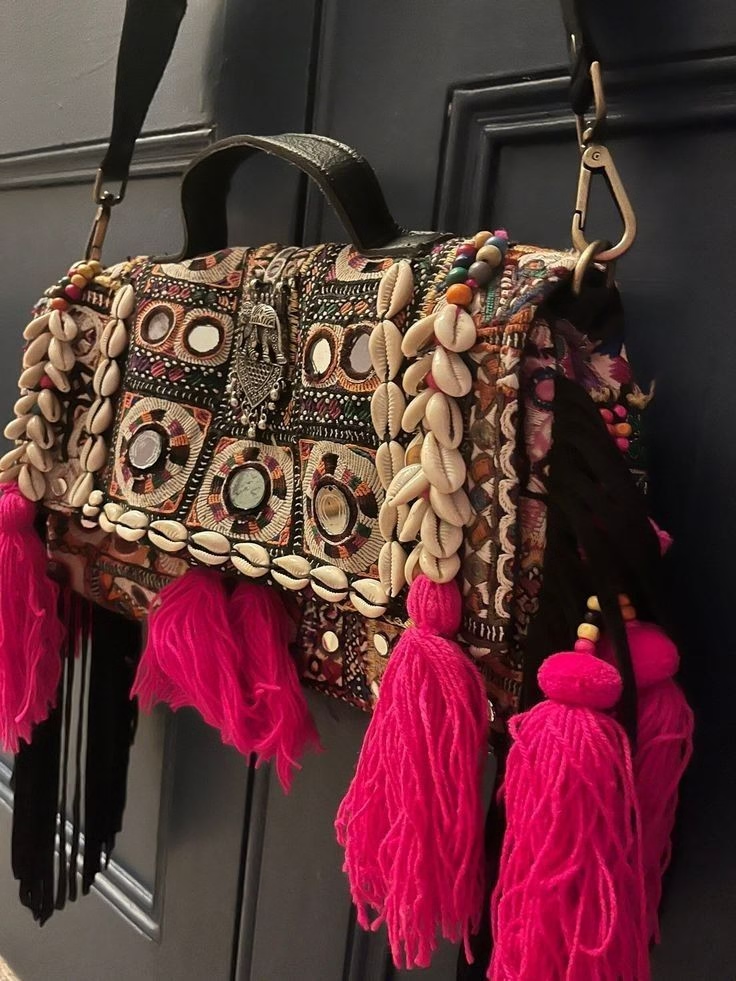
Leave a Reply